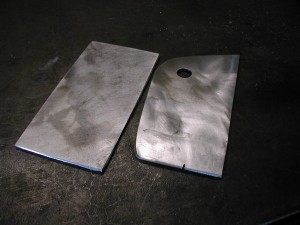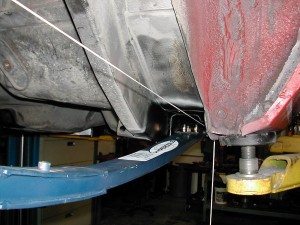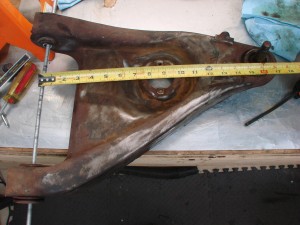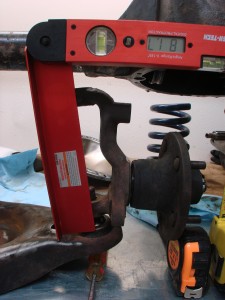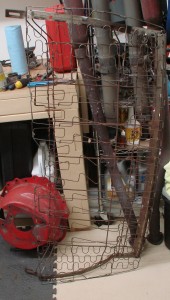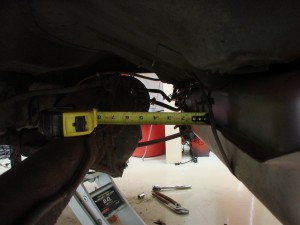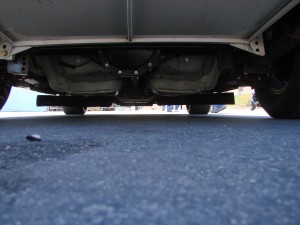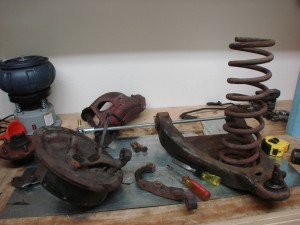Little more fab – leaf spring shackles
John made some more progress last week on the car. I’m actually very excited about the most recent thing completed – he was able to bring to life in steel, a part I’d only been able to visualize.
What part? Well, let’s just say this car will have the most kick-butt leaf spring shackles ever. 🙂
I don’t quite yet want to show the part, I’d like to wait until the car’s had its underside cleaned and painted so it’s all uniform. This is something of a hint though:
For the next couple weeks John’s been pulled into some other projects to the car’s on his back burner for a bit.
Why are old Camaros always so slow?
Them be fightin’ words in some circles but since this is my blog, it’s a fair question to ask. The context of the question today, is around why they’re slow in autocross, when seen from the eyes of a typical die-hard SCCA competitor.
One of the more interesting aspects of this project, has been the speculation and conjecture on why the car is going to be slow in STX. As a car builder, one ought to understand their platform, and in leveraging available allowances, do everything possible to minimize the impact of any deficiencies, while accentuating the strengths. We all *know* these Camaros are slow at dodging cones – but what specifically makes them so slow? Some are convinced it’s the axle-tramping rear suspension; others are sure it’s the front suspension, still others think the car won’t really be making good power vs. its competition because of optimistic 60’s SAE Gross vs. today’s Net HP ratings. Or maybe it’s way too big and heavy, maybe the brakes can’t be made to work, maybe the steering is too slow.
Well, I am sure there are many possible reasons, and until I’ve got it running and tuned as well as I think I can, we won’t know which of the above are true. Maybe none of them apply if the car is built right; maybe all of them are true, regardless of all you do (at least within ST rules).
Though I haven’t gotten too far with it yet, there are two Very Big Things I see holding these cars back in the majority of cases, that I’ll address in this post. Hopefully with my advance knowledge of these shortcomings (queue G.I. Joe) and some efforts made in mitigating them, I can overcome. Here they are below, in no particular order-
BIG THING THAT MAKES EVERY AUTOCROSS CAMARO YOU SEE SLOW #1:
The person tuning and driving that Camaro you see, doesn’t know what they’re doing and/or didn’t build their car to “go fast”. Now, I understand that statement comes across as horribly arrogant, but let me explain-
We all (or most guys, at least) tend to think we know what we’re doing the first we get behind the wheel. “Of course I’m an excellent driver”, and we continue to believe it until we see the times of somebody who really is fast.
To use one of my favorite memes in illustration,
| First I was like- |
 |
| so I was like, |
 |
| but then I was like- |
 |
You just don’t tend to see the really fast guys driving old Camaros at SCCA events, and you almost never see the really fast guys at non-SCCA events. They’re often running more modern and closer to stock Miatas or Corvettes, or whatever the hot car is that year. The best drivers tend to flock to the platforms that are believed to be competitive, because they want to win! It’s super rare to see somebody really good (and please, don’t for a second take that to mean I think I am) driving an oddball platform. What this means is the general Good Driver rule still applies to Camaros- a “really good” autocrosser could hop in the driver’s seat of a “beginner/intermediate” Camaro autocrosser, and usually beat them by a few seconds on 50-60 second course. In some ways the non-competitiveness of Camaros, and many other interesting cars, is a self-fulfulling prophecy, as those who own them are likely to get discouraged by their early results and lack of any evidence they’ll ever be competitive, leading them to to not stick with the sport long enough to get any good at it. Who knows, perhaps with some success maybe I can change that – I sure see more Nissan 240sx’s out there today than I saw before 2006.
So there’s the driving element – if the person driving that Camaro wouldn’t be competitive in the Miata or Corvette or whatever, there shouldn’t be any expectation they’ll be fast in the Camaro. Subtract a few seconds for a really great driver, and maybe the car looks a bit less bad?
The other aspect of this relates to tuning and preparing the car to go fast in autocross, and skill in this area almost exactly parallels driving, though most people seem a little more willing to admit their shortcomings in this space.
There is an unbelievable quantity of parts out there for these cars, as they’ve been undergoing speed tweaks for over 44 years now. While as best I can tell the majority of effort into these cars for decades was around drag racing, the idea of making them go fast around corners has become very hot in recent years and the parts variety reflects this. The “handling” renaissance begat a staggering quantity of suspension parts but not a lot of good guidance on what to do with them. Individuality, limitless modification options with no rules boundaries, and differing levels of willingness to sacrifice street manners on the altar of speed, have prevented the crystallization of a “spec” setup for the Camaro. A good example of a spec setup, is that for the super-popular Street-Touring 1989 Civic Si, published by Chris Shenefield about 8 years ago:
http://www.redshiftmotorsports.com/RedShift%20Tech%20Page.htm
With no spec setup to start from and no prior experience assembling a proper-handling autocross car, it’s no mystery so many of these cars end up not working very well, driving aside. The Camaro as a platform is a deep dark hole to climb out of, too difficult to expect anyone to succeed with as their first autocross tuning project. You can put your faith in what your suspension vendors tell you, but their answers are going to be targeted to the middle of their demographic, who may care more (or less) about a comfortable cruising ride, than you do.
There are some people floating around out there in the old-Camaro world who kinda know what they’re doing around the cones, I think, but since there isn’t really any sort of rules in the old-car specific events, it’s impossible to tell who’s doing a lot with a little (bit of modification), or who’s doing less, with a whole lot more. Structure and rules are frowned upon in those circles, which is a shame because it makes results impossible to use in drawing conclusions.
I guess as a message to all my fellow old Camaro owners out there – if you really want to be fast in your Camaro at the autocross (and largely also, the track) – the best thing you could probably do, is park the Camaro for a while. Get a Miata, or an S2000, or a Corvette, and go run a ton of events (SCCA preferably). Figure out who the fast guys are in your region and track your times against theirs. Even better if you get a similar car. By getting a car that’s great out of the box, you can forget about setup and focus on driving. This will teach you the importance of driving, while at the same time familiarizing you with the characteristics of a proper-handling car. When you’re ready, then go back to the Camaro – I suspect the experience gained in a “good” car will better illustrate how far you have to go with your Camaro. It should also help you better understand the importance of different modifications, and get you to spend the next few bucks on tires or shocks, instead of a supercharger.
How am I going to avoid this common problem? By drawing on my experience as a driver and a tuner from many other cars, to dig this thing out of the deep dark hole it starts out in. I don’t have any success stories to look to, but that’s part of the fun/challenge.
BIG THING THAT MAKES EVERY AUTOCROSS CAMARO YOU SEE SLOW #2:
The stock front suspension really is as bad as you’ve heard. There’s a lot of things wrong; below I’ll attempt to explain just one facet of the wrong-ness 🙂
Most of the old Camaros you see at the autocross look awful – they are too soft, and the front suspension looks like it’s doing the opposite of what it should.

Not trying to pick on this car or driver here – this photo pulled from http://www.milesspeed.com/ – a neat site I stumbled across in researching these cars. Car is owned/driven by cool chick Liz Miles, and this was taken very early on in the car’s development. Using it just to illustrate some of what’s wrong with the car’s front end; odds are if you’ve seen an old Camaro on an autocross course, it looked a lot like this.
Here’s another one from a 1967 magazine article on the original Z28:

That thing has no grip on the crap OE tires, but it still manages to showcase how utterly whacked its front suspension is.
Front grip is tremendously important in autocross. At the track if you’ve got way more power than everyone else, you can maybe get away with a pushy (understeering) car, heck, it’s more stable. But not in autocross. You need to generate big yaw/rotation, and you need to be able to change direction quickly. The front tires do all this work and it’s the front suspension’s job to keep the tires as happy as it can.
Pretty much nobody with one of these old cars is giving them enough front tire. I’ve seen cars with $10k+ in aftermarket grafted-on C6 subframes, uber expensive shocks, and mega-$ forged wheels … wrapped in 245 width tires! With 335s out back! That sort of stagger might work on a 911, with over 60% of its weight on the rear axle, but it’s a recipe for terminal understeer (and a frustrating/boring driving experience) in a 55% front-weight Camaro. If you want one of these things to turn, you need to give it all the front wheel/tire you can, and nothing made today with a DOT stamp is “too much”. My Viper had about the same front weight as most of these Camaros, and it had 335s up front! At that size things were just starting to work right. 🙂 Obviously packaging is a problem but with all the effort put into everything else, I don’t see why more of those guys aren’t running at least 285s up front.
So to the subject of analysis here – the motion ratio – and boy is it TERRIBLE! To many that may not mean anything, so let me attempt to explain. Below is a photo of a stock ’67 Camaro lower control arm. At the far left, the rod illustrates the axis upon which the arm pivots. At a bit past 8.5 inches down the tape measure, are the two bolts that hold the shock. When installed, the spring sits concentrically around the shock. At the far end, just under 16 inches, is the lower ball joint’s pivot point. Though you can’t see it here, there’s a hole for the stock swaybar attachment at about 13.5 inches.
So what’s the motion ratio, and why do I care? Well, the motion ratio, is the ratio between how far the wheel moves, compared to how far the shock absorber (or spring) moves. The further out on the arm the spring/shock attach, the higher (and better) the motion ratio. To calculate the motion ratio, you take the distance from the inner pivot to the spring/shock attachment, and divide it by the distance from inner pivot to lower ball joint pivot. If we round the pictured measurements a bit, we get:
Motion Ratio = 9/16 = .5625
This means, for every inch of wheel movement, we only are going to see .5625″ of spring/shock movement. Okay, so why’s that bad?
It’s bad because we depend on our shocks to damp the motion of both our unsprung (wheel/tire, 1/2 our suspension) and sprung (the rest of the car) weight. The better a job the shock can do, the more consistently loaded our tires will be, the more grip we’ll have, the faster the car will go around the corner, the lower our laptimes. This motion ratio is about 30% lower than the motion ratio of a good modern car.
Below is a pic of a Viper’s front corner – look at how the spring and shock attach waaaaay out on the arm, right next to the lower ball joint: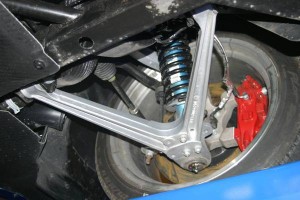
The Viper enjoys a much much better motion ratio than the Camaro.
Shocks depend on velocity to do their job – if they are not moving, they are not displacing fluid, which means they aren’t doing anything. The more shock travel we can get per unit of wheel travel, the better we can control every microscopic bit of that wheel travel. This also allows us to control things with lower shock forces, which makes it easier to find reasonably priced units.
In an autocross car with a good motion ratio, we’re generally looking for what the shock does at about 3 inches/second on a force vs. velocity graph (explained somewhat here: http://farnorthracing.com/autocross_secrets20.html ). Most of the movements the suspension sees on an autocross course are in this speed range, so that’s where we care about what our shocks are doing. Shock velocities above that speed (bumps) are important too but somewhat less so, they’ll be a subject for a later day.
So getting back to the Camaro – with a motion ration of .5625, we’re only getting about 2/3 the shock travel or velocity, of a “good” suspension car. So whereas they get to build their shocks to work at 3 in/sec, ours have to be doing the same quality of control, with 2 in/sec. The problem is, accurate control and large forces at these low shaft speeds, are very hard to come by – any of the common shocks available over-the-counter just aren’t going to get it done, at least not very well. But wait, it gets worse!
Spring rate by itself is a not very good indicator of how stiff a car is – what’s more useful is the “wheel rate”, or maybe the “natural frequency” of a suspension. Here’s an online calculator if you’re interested to find out yours: http://www.racingaspirations.com/?p=292
Those that have ever ridden in an unladen 1-ton pickup truck, and been bounced all around, have experienced a high wheel rate, and a high natural frequency. The high natural frequency is caused by a very high wheel rate, combined with not much weight on the spring (an empty truck bed). If you’ve ever then loaded up that bed with a few thousand pounds and noticed the truck suddenly rode much more comfortably, it’s not because the wheel rate went down (in some leaf systems, it might actually have gone up) – it’s because the natural frequency has gone way way down due to the weight/load in the bed.
We arrive at wheel rate by taking the motion ratio, and multiplying it by itself – “squaring it”, in math terms, then multiplying it by our regular spring rate. In the Camaro’s case, .5625*.5625=.316. That means that for every 1 pound of spring rate, we are going to have .316 pounds of wheel rate.
Wheel rate and natural frequency are concepts you can use to compare the stiffness of any two cars, regardless of suspension type. You’ll often see sliding scales where 1hz is “comfy street car”, 1.5hz, “sporty car”, 2.0hz “race car”, 3.0+hz “race car with aero downforce” – something like that. Those are really just broad generalizations and by no means limits on what you can do with your car.
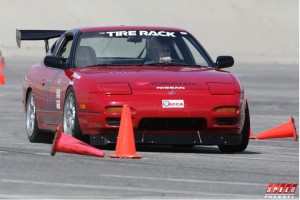 If you’re setting up a car to handle well, 2.0hz isn’t a terrible place to start. If you’ve driven other prepared-suspension cars that you really liked, that were of a similar layout (RWD, FWD, AWD), it might be worthwhile examining that car’s frequencies and consider it as a baseline. For instance, my 240sx used a 550lb. front spring when it was in STS (street tire) trim. It had a bit over 700lbs. of total weight per front corner, about 55lb. unsprung. It used a strut front suspension which granted a motion ratio of about .96. Its 550lb. spring netted a ~500lb wheel rate, and with the car’s weight, its natural frequency was around 2.7hz. While this was way higher than anybody is likely to recommend for a daily driver, it wasn’t terrible on the street, but more importantly, it wasn’t so stiff that the street tire wasn’t working well. The car worked great!
If you’re setting up a car to handle well, 2.0hz isn’t a terrible place to start. If you’ve driven other prepared-suspension cars that you really liked, that were of a similar layout (RWD, FWD, AWD), it might be worthwhile examining that car’s frequencies and consider it as a baseline. For instance, my 240sx used a 550lb. front spring when it was in STS (street tire) trim. It had a bit over 700lbs. of total weight per front corner, about 55lb. unsprung. It used a strut front suspension which granted a motion ratio of about .96. Its 550lb. spring netted a ~500lb wheel rate, and with the car’s weight, its natural frequency was around 2.7hz. While this was way higher than anybody is likely to recommend for a daily driver, it wasn’t terrible on the street, but more importantly, it wasn’t so stiff that the street tire wasn’t working well. The car worked great!
A similar calc on the rear of an STS Civic I built, puts the frequency around 3.5hz! Some guys I know are running springs up in the 4-5hz range on the rear of those cars.
So getting back to the Camaro, now knowing the 240’s numbers (500lb. wheel rate, 2.7hz) as a ballpark. With our Camaro’s motion ratio, to get a 500lb. wheel rate, we’d need (500/.316)=1582lb. springs! Even at that rate, our frequency is only going to be a bit over 2.5hz, in some ways softer than the 240sx. To get to the same frequency I’d need springs up around 1820lb./in!
Ugg, now we’ve got not much shock velocity to control our wheel motion, and on top of it, we’re going to have to run crazy stiff springs to get this thing to the stiffness level we want.
There are a lot of things “less than ideal” about the Camaro’s front end geometry – bump steer, camber curves, etc., that I can’t really fix in ST, and that you can’t really fix with the stock subframe. In an earlier post I mentioned my plan for dealing with these was to set the static numbers good and “not let it move much”. You can see now why people hadn’t really tried that approach before – they couldn’t! No normal shock you could buy off the shelf would damp a 4-digit spring given an equal motion ratio; things that stiff were just outside the bounds of people’s thinking. About the stiffest I’ve seen anyone run is 800lb. springs, for a 250lb. wheel rate, about half what I’ve depicted above. It’s no wonder people were so concerned with bump steer and camber curves – at that low a wheel rate, the suspension would experience large (double to triple) the quantity of travel as the more stiffly sprung version, so the negative effects of bad bumpsteer/camber curves would also be doubled or tripled. It also means they had to run their cars a lot higher, which is a Big Bummer for them, we’ll explore later.
So to bring this home-
Bad motion ratio gives shocks poor control of sprung/unsprung motions, leading to inconsistent tire loading
Bad motion ratio creates a lot of suspension travel at “normal” spring rates, exacerbating the problems with the stock suspension’s camber and bumpsteer curves and necessitating higher front CG
How am I going to avoid letting this screw me up? Simple answer – great shocks! The 28-series Konis I have, were originally designed a few years back for high-downforce Indy cars, where there are very large forces needed at very small suspension displacements. Even though an autocrossing ’67 Camaro is a long ways from a recent Indy car, the characteristics needed end up being quite similar. There are many other high-end brands (Penske, Ohlins, Moton, AST, JRZ, Sachs, and more) than can get this done too, Koni just happens to be the one I’m most familiar with. With a little bit of revalving, they are going to allow me to run these really high spring rates, while maintaining good wheel control, something a lower-end shock wouldn’t.
Lots more wrong with front suspension, more to come on that later…
Further suspension dissection
Got a bit further into the suspension today.
Thought I’d start the day by pulling the seat covers off the rear seat frame, to help get rid of some of the smelly funk in the garage. I had planned to maybe replace the whole thing, but each frame for the bottom and back is bucks ($600+) so figured I’d strip it down the the frame, powdercoat, then re-cover.
There were TWO covers on the bottom! Instead of re-covering the original, someone put a new black cover over the original blue vinyl. All this mess was held in by a million of the little metal bent staple things. Probably a pound weight savings right there! Will be nice to have that stinky stuff gone but doing so burned a ton of time.
So on to the rear suspension. Got the rear axle free of the springs and brake lines, and jacked it up to around where I figured its “working” ride height would be. Wanted to see how much room there’d be to package the gear I have in mind for back there-
Looks like 5″ from this pic but it’s really more like 4-4.5″. Will probably be enough for what I want to do. I imagine some people are expecting me to introduce some kind of new-fangled cutting edge live axle lateral locating device, but unfortunately for them, I have no such plans. Effectiveness, light weight, and simplicity are the goals. Surprisingly, none of the big aftermarket vendors for these cars make a simple panhard rod kit. There are a few watts link kits out there, but they all look very heavy.
Below is a simple and effective lateral locating device found on a very successful car.
From the factory, the car depends on the leaf springs to function as the springing medium, but to also control the axle’s lateral, longitudinal, and torque movements. In a way this is really clever, as you don’t need all sort of control arms and bushings, it is all really simple. Unfortunately as with anything you ask to do too many things, the leafs end up compromised and not doing any one of those tasks very well.
Below are the leaf springs I plan on running, at least initially. I have to stick with leaf springs per my rules, can’t go to coils, and things like springs embedded within the shocks are also not allowed. I could try to do some sort of crazy progressive bump stop tuning to use those as the spring, but I don’t like bump stops and don’t plan on running any.
These are Hypercoil composite leaf springs, one of them side-by-side with a stock mono-leaf rear spring. The Hypercoil spring here is 250lb/in., and has about 3″ less “arch” than the stock spring. I suspect even with that much less arch, the rear of the car is going to be too high for my purposes. The spring I pulled off the car had a rate probably around 80lb/in. The ’67 Z28 had a stiffer stock rate, probably around 125lb/in. Double that rate sounds high but I don’t suspect it will be, as tire and shock technology has come a long way.
This will give the rear a ride frequency just over 2hz, which should be in the ballpark. There is no real “motion ratio” for a live axle in ride, a 1″ suspension movement equates to 1″ of spring compression.
Ride height adjusments aren’t very easily done with longitudinal leaf springs, so that’s something I’ll have to work out when the time comes.
Oh, these composite rear leafs as a pair are over 11 pounds lighter than my super-soft stock rear steel mono leafs. Not a huge reduction, but for a car using big multi-leafs to achieve a high rate, probably lots more weight to be lost.
The front fares a bit better. It uses a traditional upper and lower a-arm suspension, albeit with really awful geometry. It’s funny to see, at full droop, the car actually has several degrees of negative caster.
The stock spring is 16″ long! 16″ also happens to be the effective length of the lower control arm – the distance from their inner pivot point, to the center of the lower ball joint.
The shock mount and spring seat is centered at a distance of 9″ from the inner pivot point. This gives a not-too-great motion ratio of .316. What this means, is we don’t get a lot of travel at the spring/shock for a unit of travel at the wheel/tire. This necessitates higher spring rates, and shocks that can properly handle those higher spring rates. Fortunately I have a really great set of shocks left over from the Viper, so I should be able to get the valving I need. I haven’t seen the motion ratio for a first-gen Camaro published before and didn’t know how it would be until I put the arm on the workbench today. Seeing it now I’m not surprised people have trouble getting them to work well with stiff springs. Unless you go to a custom arm that really improves the motion ratio, you’re going to need a shock capable of massive low-speed damping to keep one of these front suspensions under control.
My STS 240sx used 550lb. front springs with a strut suspension that provided near a 1:1 motion ratio, its wheel rate was around 500. That was pretty high for a car that only had about 700 pounds on each front corner. Like the Camaro, it had really bad suspension geometry, especially when lowered, so I used a fairly high spring rate to keep it from moving too much; it also had a sharp fender seam that would cut into the tire on a bad bump.
To get an equivalent wheel rate is going to require a spring rate well up into the 4-digit range, over 1500lb/in. by my calculations. I probably won’t go quite that stiff, at least not at first, as I plan to use a stiffer front sway bar on the Camaro than I used on the 240sx. The stock spring rate on my Camaro was around 330lb./in, the Z28 of this year only had about 380lb.in.
I believe it was Colin Chapman who was credited as having once said “Any suspension will work…if you don’t let it”
My interpretation of this sentiment, is that if you can set your static figures (camber, caster, toe) in a good and happy place, then just not let the suspension move very much, you are probably going to be okay. Things like camber curves and bump steer curves are important, and if you’re in a class where the rules allow you to properly re-engineer those things, doing so is worthwhile. But if you aren’t allowed to re-engineer those things, and are dealt (or choose) a car with crummy bump steer and camber curves, then give the car plenty of static negative camber (I ran -4.5 degrees on the 240sx) and make it stiff enough so the outside front tire is still in a “happy place” at terminal roll. Sure, your inside front tire may be riding on its inner edge, but especially in these big heavy production cars, the outside tire does pretty much all the work in the corner anyway.
So the above summarizes my philosophy and approach to how I plan to make the front suspension on this car work. It’s going to have a lot of static negative camber, people will probably think it looks funny. Donohue never figured out a way to get the front of his car to work without a ton of static negative either, so who am I to try?
I’m also a big fan of adjustability, so the finished front suspension will fully adjustable for ride height, camber, caster, and toe using a combination of both the factory methods and the allowances we have in ST for camber kits and replacement control arms. I think it is important as a builder to give yourself a wide range of adjustment, and to never be at the extreme of any adjustment range you have. You should always have one more hole, or shim, or click of the knob to go in any direction, at least under normal circumstances (i.e., a normal dry surface).
